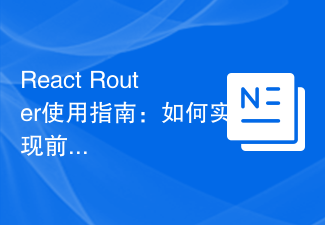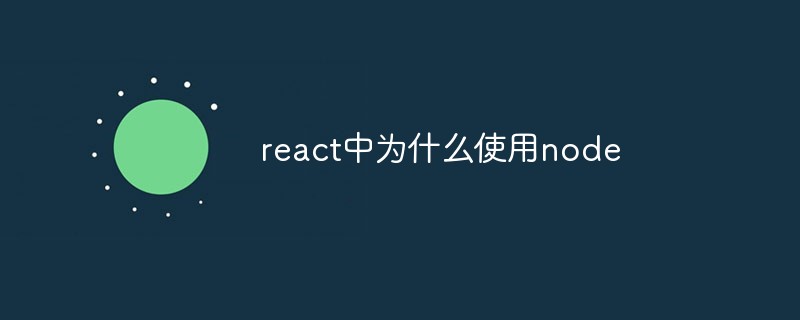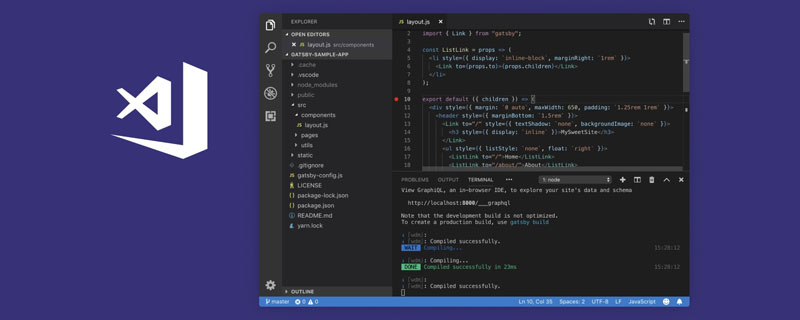This article mainly introduces the React Router v4 entry guide (summary). The editor thinks it is quite good, so I will share it with you now and give it as a reference. Let’s follow the editor and take a look.
It has been three months since React Router v4 was officially released. This week, a React shelf was upgraded. The previous routing was still using version v2.7.0. , so I decided to upgrade the routing as well, just to "try something new"...
Rumors in the world are that the official currently maintains two versions of 2.x and 4.x at the same time. (ヾ(。ꏿ﹏ꏿ)ノ゙Hey, at this moment, I believe that you who are as smart as me will also find out, where has ReactRouter v3 gone? Lost it all?? Bala is out of trouble??? Dare you give me a perfect one? Explanation!?) In fact, version 3.x does not introduce any new features compared to version 2.x, it just removes the warnings of some obsolete APIs in version 2.x. According to the plan, when new projects without historical baggage want to use the stable version of ReactRouter, they should use ReactRouter 3.x. The 3.x version is currently still in the beta stage, but will be officially released before the 4.x version. If you are already using version 2.x, upgrading to 3.x will not require any additional code changes.
Polite introduction

React Router V4 has fundamental changes compared to the previous three versions. The first is to follow# The API design concept of ##Just Component, and secondly, the API aspect has also been streamlined a lot, which reduces the difficulty of learning for novices, but if it is a reconstruction of the previous project, well, there is simply nothing to say. The main features of this upgrade are as follows:
- Declarative
- Composability
Everything is a component. Therefore, the upgraded Route, Link, Switch, etc. are all common components.
React Router V4 manages multiple Repositories based on Lerna. Included in this code base:- react-router React Router core
- react-router-dom React Router for DOM binding
- react-router-native React Router for React Native
- react-router-redux Integration of React Router and Redux
- react-router-config Static routing configuration help assistant
Initial introduction of the plug-in
Usually we are in React In use, two packages are generally introduced,react and react-dom, then react-router and react-router-dom Do they need to be quoted from both? Attention, there is high energy ahead, the first pit to get started is right here. They only need to reference one of them. The difference is that the latter has more DOM class components like <link> than the former. So we only need to quote the react-router-dom package and it's OK. Of course, if paired with redux, you also need to use react-router-redux.
Introduction to the main components
In the API version before 4.0, the children of the component can only be the various components provided by React Router. Various components, such as , etc. In React Router 4, you can put various components and labels into the component, and its role is more like the in Redux. . **The difference is that is used to keep updated with the store, while is used to keep synchronized with the location. **Examples are as follows:
// 示例1
<Router>
<p>
<ul>
<li><Link to="/">首页</Link></li>
<li><Link to="/about">关于</Link></li>
<li><Link to="/topics">主题列表</Link></li>
</ul>
<hr/>
<Route exact path="/" component={Home}/>
<Route path="/about" component={About}/>
<Route path="/topics" component={Topics}/>
</p>
</Router>
Router is the underlying interface shared by all routing components. Generally, our applications will not use this interface, but use advanced Routing:
: Use the history API provided by HTML5 to keep the UI and URL synchronized;: Use URL hash (for example: window.location.hash) to keep the UI and URL synchronized;: Can save the history of your "URL" in memory (without reading and writing the address bar);- ##
: Provides routing support for using React Native;
## - : Never changes the address;
TIPS : This is the second pitfall. Unlike the previous Router, only one child element is allowed under the
The negative example is here:
<Router>
<ul>
<li><Link to="/">首页</Link></li>
<li><Link to="/about">关于</Link></li>
<li><Link to="/topics">主题列表</Link></li>
</ul>
<hr/>
<Route exact path="/" component={Home}/>
<Route path="/about" component={About}/>
<Route path="/topics" component={Topics}/>
</Router>
Yes, Example 2 is without
Dad’s protection Next, the following exception message will be reported:

我们知道,Route组件主要的作用就是当一个location匹配路由的path时,渲染某些UI。示例如下:
<Router>
<p>
<Route exact path="/" component={Home}/>
<Route path="/news" component={NewsFeed}/>
</p>
</Router>
// 如果应用的地址是/,那么相应的UI会类似这个样子:
<p>
<Home/>
</p>
// 如果应用的地址是/news,那么相应的UI就会成为这个样子:
<p>
<NewsFeed/>
</p>
<route></route> 组件有如下属性:
path(string): 路由匹配路径。(没有path属性的Route 总是会 匹配);
exact(bool):为true时,则要求路径与location.pathname必须完全匹配;
strict(bool):true的时候,有结尾斜线的路径只能匹配有斜线的location.pathname;
再次奉上两个鲜活的例子:
exact配置:
| 路径 | location.pathname | exact | 是否匹配 |
|---|---|---|---|
| /one | /one/two | true | 否 |
| /one | /one/two | false | 是 |
strict配置:
| 路径 | location.pathname | strict | 是否匹配 |
|---|---|---|---|
| /one/ | /one | true | 否 |
| /one/ | /one/ | true | 是 |
| /one/ | /one/two | true | 是 |
同时,新版的路由为 <route></route> 提供了三种渲染内容的方法:
<route component></route>:在地址匹配的时候React的组件才会被渲染,route props也会随着一起被渲染;<route render></route>:这种方式对于内联渲染和包装组件却不引起意料之外的重新挂载特别方便;<route children></route>:与render属性的工作方式基本一样,除了它是不管地址匹配与否都会被调用;
第一种方式没啥可说的,和之前一样,这里我们重点看下 <route render></route> 的渲染方式:
// 行内渲染示例
<Route path="/home" render={() => <p>Home</p>}/>
// 包装/合成
const FadingRoute = ({ component: Component, ...rest }) => (
<Route {...rest} render={props => (
<FadeIn>
<Component {...props}/>
</FadeIn>
)}/>
)
<FadingRoute path="/cool" component={Something}/>
TIPS: 第三坑! <route component></route> 的优先级要比 <route render></route> 高,所以不要在同一个 <route></route> 中同时使用这两个属性。
和之前版本没太大区别,重点看下组件属性:
to(string/object):要跳转的路径或地址;
replace(bool): 为 true 时 ,点击链接后将使用新地址替换掉访问历史记录里面的原地址; 为 false 时 ,点击链接后将在原有访问历史记录的基础上添加一个新的纪录。 默认为 false ;
示例如下:
// Link组件示例
// to为string
<Link to="/about">关于</Link>
// to为obj
<Link to={{
pathname: '/courses',
search: '?sort=name',
hash: '#the-hash',
state: { fromDashboard: true }
}}/>
// replace
<Link to="/courses" replace />
<navlink></navlink> 是 <link> 的一个特定版本, 会在匹配上当前 URL 的时候会给已经渲染的元素添加样式参数,组件属性:
activeClassName(string):设置选中样式,默认值为 active;
activeStyle(object):当元素被选中时, 为此元素添加样式;
exact(bool):为 true 时, 只有当地址完全匹配 class 和 style 才会应用;
strict(bool):为 true 时,在确定位置是否与当前 URL 匹配时,将考虑位置 pathname 后的斜线; isActive(func):判断链接是否激活的额外逻辑的功能;
从这里我们也可以看出,新版本的路由在组件化上面确实下了不少功夫,来看看NavLink的使用示例:
// activeClassName选中时样式为selected
<NavLink
to="/faq"
activeClassName="selected"
>FAQs</NavLink>
// 选中时样式为activeStyle的样式设置
<NavLink
to="/faq"
activeStyle={{
fontWeight: 'bold',
color: 'red'
}}
>FAQs</NavLink>
// 当event id为奇数的时候,激活链接
const oddEvent = (match, location) => {
if (!match) {
return false
}
const eventID = parseInt(match.params.eventID)
return !isNaN(eventID) && eventID % 2 === 1
}
<NavLink
to="/events/123"
isActive={oddEvent}
>Event 123</NavLink>
该组件用来渲染匹配地址的第一个 <route></route> 或者 <redirect></redirect> 。那么它与使用一堆route又有什么区别呢?
<switch></switch> 的独特之处是独它仅仅渲染一个路由。相反地,每一个包含匹配地址(location)的 <route></route> 都会被渲染。思考下面的代码:
<Route path="/about" component={About}/>
<Route path="/:user" component={User}/>
<Route component={NoMatch}/>
如果现在的URL是 /about ,那么 <about></about> , <user></user> , 还有 <nomatch></nomatch> 都会被渲染,因为它们都与路径(path)匹配。这种设计,允许我们以多种方式将多个 <route></route> 组合到我们的应用程序中,例如侧栏(sidebars),面包屑(breadcrumbs),bootstrap tabs等等。 然而,偶尔我们只想选择一个 <route></route> 来渲染。如果我们现在处于 /about ,我们也不希望匹配 /:user (或者显示我们的 “404” 页面 )。以下是使用 Switch 的方法来实现:
<Switch>
<Route exact path="/" component={Home}/>
<Route path="/about" component={About}/>
<Route path="/:user" component={User}/>
<Route component={NoMatch}/>
</Switch>
现在,如果我们处于 /about , <switch></switch> 将开始寻找匹配的 <route></route> 。 <route path="/about"></route> 将被匹配, <switch></switch> 将停止寻找匹配并渲染 <about></about> 。同样,如果我们处于 /michael , <user></user> 将被渲染。
上面是我整理给大家的,希望今后会对大家有帮助。
相关文章:
The above is the detailed content of React Router v4 Getting Started Guide. For more information, please follow other related articles on the PHP Chinese website!
 React Router使用指南:如何实现前端路由控制Sep 29, 2023 pm 05:45 PM
React Router使用指南:如何实现前端路由控制Sep 29, 2023 pm 05:45 PMReactRouter使用指南:如何实现前端路由控制随着单页应用的流行,前端路由成为了一个不可忽视的重要部分。ReactRouter作为React生态系统中最受欢迎的路由库,提供了丰富的功能和易用的API,使得前端路由的实现变得非常简单和灵活。本文将介绍ReactRouter的使用方法,并提供一些具体的代码示例。安装ReactRouter首先,我们需
 react中antd和dva是什么意思Apr 21, 2022 pm 03:25 PM
react中antd和dva是什么意思Apr 21, 2022 pm 03:25 PM在react中,antd是基于Ant Design的React UI组件库,主要用于研发企业级中后台产品;dva是一个基于redux和“redux-saga”的数据流方案,内置了“react-router”和fetch,可理解为应用框架。
 React是双向数据流吗Apr 21, 2022 am 11:18 AM
React是双向数据流吗Apr 21, 2022 am 11:18 AMReact不是双向数据流,而是单向数据流。单向数据流是指数据在某个节点被改动后,只会影响一个方向上的其他节点;React中的表现就是数据主要通过props从父节点传递到子节点,若父级的某个props改变了,React会重渲染所有子节点。
 react中为什么使用nodeApr 21, 2022 am 10:34 AM
react中为什么使用nodeApr 21, 2022 am 10:34 AM因为在react中需要利用到webpack,而webpack依赖nodejs;webpack是一个模块打包机,在执行打包压缩的时候是依赖nodejs的,没有nodejs就不能使用webpack,所以react需要使用nodejs。
 react中forceupdate的用法是什么Apr 19, 2022 pm 12:03 PM
react中forceupdate的用法是什么Apr 19, 2022 pm 12:03 PM在react中,forceupdate()用于强制使组件跳过shouldComponentUpdate(),直接调用render(),可以触发组件的正常生命周期方法,语法为“component.forceUpdate(callback)”。
 react native怎么删除组件Apr 21, 2022 pm 04:10 PM
react native怎么删除组件Apr 21, 2022 pm 04:10 PMreact native可以利用“npm uninstall --save 组件”删除组件;npm可用于管理第三方组件包,参数设置为uninstall时,可用于删除软件包,参数“--save”表示会从“packages.json”中获取包。
 react有没有双向绑定Apr 21, 2022 am 10:24 AM
react有没有双向绑定Apr 21, 2022 am 10:24 AMreact中没有双向绑定;react的设计思想就是单向数据流,没有双向绑定的概念;react是view层,单项数据流只能由父组件通过props将数据传递给子组件,满足了view层渲染的要求并且更易测试与控制,所以在react中没有双向绑定。
 VSCode插件分享:一个实时预览Vue/React组件的插件Mar 17, 2022 pm 08:07 PM
VSCode插件分享:一个实时预览Vue/React组件的插件Mar 17, 2022 pm 08:07 PM在VSCode中开发Vue/React组件时,怎么实时预览组件?本篇文章就给大家分享一个VSCode 中实时预览Vue/React组件的插件,希望对大家有所帮助!


Hot AI Tools

Undresser.AI Undress
AI-powered app for creating realistic nude photos

AI Clothes Remover
Online AI tool for removing clothes from photos.

Undress AI Tool
Undress images for free

Clothoff.io
AI clothes remover

AI Hentai Generator
Generate AI Hentai for free.

Hot Article

Hot Tools

Dreamweaver Mac version
Visual web development tools

VSCode Windows 64-bit Download
A free and powerful IDE editor launched by Microsoft

MinGW - Minimalist GNU for Windows
This project is in the process of being migrated to osdn.net/projects/mingw, you can continue to follow us there. MinGW: A native Windows port of the GNU Compiler Collection (GCC), freely distributable import libraries and header files for building native Windows applications; includes extensions to the MSVC runtime to support C99 functionality. All MinGW software can run on 64-bit Windows platforms.

PhpStorm Mac version
The latest (2018.2.1) professional PHP integrated development tool

SAP NetWeaver Server Adapter for Eclipse
Integrate Eclipse with SAP NetWeaver application server.






